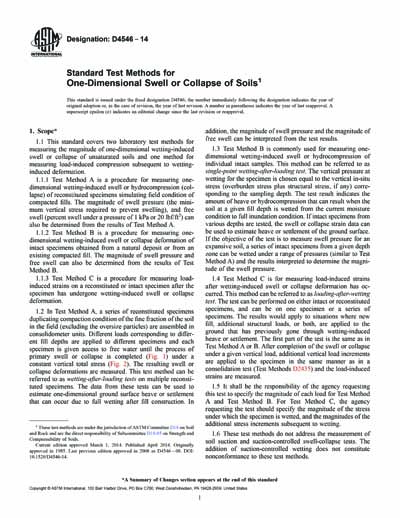Historical
ASTM D4546-14
Standard Test Methods for One-Dimensional Swell or Collapse of Soils
1.1 This standard covers two laboratory test methods for measuring the magnitude of one-dimensional wetting-induced swell or collapse of unsaturated soils and one method for measuring load-induced compression subsequent to wetting-induced deformation.
/div>1.2 In Test Method A, a series of reconstituted specimens duplicating compaction condition of the fine fraction of the soil in the field (excluding the oversize particles) are assembled in consolidometer units. Different loads corresponding to different fill depths are applied to different specimens and each specimen is given access to free water until the process of primary swell or collapse is completed (Fig. 1) under a constant vertical total stress (Fig. 2). The resulting swell or collapse deformations are measured. This test method can be referred to as wetting-after-loading tests on multiple reconstituted specimens. The data from these tests can be used to estimate one-dimensional ground surface heave or settlement that can occur due to full wetting after fill construction. In addition, the magnitude of swell pressure and the magnitude of free swell can be interpreted from the test results.
1.3 Test Method B is commonly used for measuring one-dimensional wetting-induced swell or hydrocompression of individual intact samples. This method can be referred to as single-point wetting-after-loading test. The vertical pressure at wetting for the specimen is chosen equal to the vertical in-situ stress (overburden stress plus structural stress, if any) corresponding to the sampling depth. The test result indicates the amount of heave or hydrocompression that can result when the soil at a given fill depth is wetted from the current moisture condition to full inundation condition. If intact specimens from various depths are tested, the swell or collapse strain data can be used to estimate heave or settlement of the ground surface. If the objective of the test is to measure swell pressure for an expansive soil, a series of intact specimens from a given depth zone can be wetted under a range of pressures (similar to Test Method A) and the results interpreted to determine the magnitude of the swell pressure.
Content Provider
ASTM International [astm]






